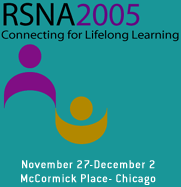
Abstract Archives of the RSNA, 2005
Livio Carpanese MD, Abstract Co-Author: Nothing to Disclose
Giuseppe Pizzi MD, Presenter: Nothing to Disclose
Giulio Vallati MD, Abstract Co-Author: Nothing to Disclose
Salvatore Guaglianone MD, Abstract Co-Author: Nothing to Disclose
Michele Gallucci MD, Abstract Co-Author: Nothing to Disclose
Marcello Crecco MD, Abstract Co-Author: Nothing to Disclose
High risk of bleeding,during laparoscopic partial nephrectomy of tumor excision,is a quite common event. The authors evaluated the effectiveness of superselective hypervascular renal tumors embolization before performing laparoscopic partial nephrectomy,to decrease periprocedural haemorrhagic complications.
From August 2003 to December 2004 the procedure was performed in 30 patients with small, solitary, enhancing, predominantly exophitic, renal tumor. Mean tumor size was 3.3 cm, and no lesion was close to the pelvicaliceal system. Superselective trans arterial embolization was performed through coaxial micro catheters system using 300-700 μm hydrogel microspheres, produced from PVA, into the arteries feeding the tumor and the surrounding parenchyma, in order to obtain a small controlled infarction of the area. Tumor embolization was confirmed according to angiographic criteria including vascular stasis and absence of further arterial feeders. About 24 hours after the embolization, patients underwent a laparoscopic partial nephrectomy,in balanced general anesthesia.
Mean operative time was measured, as like the mean estimated blood loss, the pain control, and post-operative hospital outcome.
No loss of viable renal tissue occurred as consequence of the interventional procedure. Mean operative time of embolic procedure was of 45 minutes.
Mean operative time was of 80 minutes and a mean estimated blood loss was of 230 ml. No patient required blood transfusion. Average hospital outcome was 7 days, while complications were only reported in 2 patients (one with infected hematoma, the other with a necrotic mass, not protruding from the renal surface, converted to an open procedure).
Laparoscopic procedure allows easy access to the kidney and does not require wide incisions; however,the major trouble is to achieve an adequate hemostasis of possible bleeding(which is often plentiful) from surgical field, like in open procedures. Superselective embolization of renal neoplasms permits a clear boundary line between healthy and necrotic parenchyma and is effective, in the management and control of possible active periprocedural bleeding during laparoscopic treatment.
Carpanese, L,
Pizzi, G,
Vallati, G,
Guaglianone, S,
Gallucci, M,
Crecco, M,
Role of Superselective Renal Tumors Transcatheter Embolization before Laparoscopic Partial Nephrectomy: Methods, Safety, and Efficacy. Radiological Society of North America 2005 Scientific Assembly and Annual Meeting, November 27 - December 2, 2005 ,Chicago IL.
http://archive.rsna.org/2005/4418925.html

